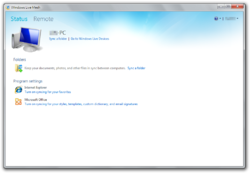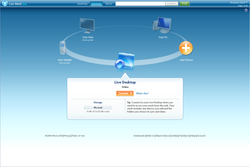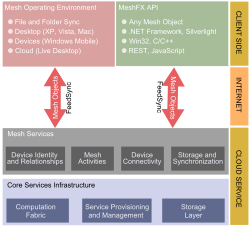- Windows Live Mesh
-
Windows Live Mesh 

Windows Live MeshDeveloper(s) Microsoft Stable release 2011 (15.4.3538.0513 Win, 15.4.5726.23 Mac) / July 20, 2011 Operating system Microsoft Windows and Mac OS X (Intel Only)[1] Type File sharing Website explore.live.com/windows-live-mesh Windows Live Mesh (formerly known as Live Mesh, Windows Live Sync and Windows Live FolderShare)[2] is a free-to-use Internet-based file synchronization application by Microsoft that is designed to allow files and folders between two or more computers be in sync with each other on Windows (Vista and later) and Mac OS X (v. 10.5 Leopard and later, Intel processors only) computers or the Web via Windows Live SkyDrive.[3] Windows Live Mesh also enables remote desktop access via the Internet.
Windows Live Mesh is part of the free Windows Live Essentials suite of software.
Contents
Features
Features of Windows Live Mesh include:
- Ability to sync up to 200 folders with 100,000 files each (each file up to 40 GB)[4] for PC-to-PC synchronisations
- Ability to sync up to 5 GB of files to "SkyDrive synced storage" in the cloud
- Remote Desktop access via Windows Live Mesh and the Windows Live Devices web service
- PC-to-PC synchronisation of application settings for applications such as:
- Windows Internet Explorer - synchronisation of favorites and recently typed URLs between computers
- Microsoft Office - synchronisation of dictionaries, Outlook email signatures, styles and templates between computers
History
Microsoft bought FolderShare from ByteTaxi Inc. on November 3, 2005, and subsequently made it a part of their Windows Live range of services.[5]
On March 10, 2008, Microsoft released its first user visible update to the then Windows Live FolderShare. This comprised a rewrite of the FolderShare website and an updated Windows Live FolderShare client. Support for discussion groups and Remote Desktop Search was also removed in the update. The new client had some user interface and branding updates and contained several bug fixes - including official support for Windows Vista and discontinued support for Windows 2000.
Since its rebrand as Windows Live FolderShare, the client and service had undergone extensive platform changes, switching from the original LAMP which it was originally built on when acquired, to the Windows Server platform. In the Windows Live Essentials "Wave 3" release, Windows Live FolderShare was again rebranded as Windows Live Sync. New UI improvements were also announced to be part of the "Wave 3" release, integrating it with other Windows Live services. New features of the then Windows Live Sync "Wave 3" compared to FolderShare included increased limit of sync folders, integration with Windows Live ID, integration with Recycle Bin, unicode support, support for Mac OS X, and integration with Windows Live Photo Gallery and Windows Live Toolbar to sync photo albums and favorites between PCs.[6] Windows Live Sync Wave 3 was released on December 11, 2008,[7] and an update of Windows Live Sync for Mac was released on November 2, 2009 to add support for Mac OS X 10.6.[8]
Live Mesh Beta
See also: Windows Live DevicesMicrosoft released the Live Mesh technology preview on April 23, 2008, a data synchronization system that allowed files, folders and other data to be shared and synchronized across multiple personal devices and up to 5 GB on the web.[9] Live Mesh was based on FeedSync technologies to convey the changes made in each device so that the changes can be synchronized across all devices and the cloud.[10] The information about devices and folders participating in a synchronization relationship was not stored locally but at the service-end.[11]
The Live Mesh software, called Mesh Operating Environment (MOE),[12] was available for Windows XP, Windows Vista, Windows 7, Mac OS X, as well as Windows Mobile 6.[13] It could be used to create and manage the synchronization relationships between devices and data. Live Mesh also included a cloud storage component, called Live Desktop, which was an online storage service that allows synchronized folders to be accessible via a website.[9] Live Mesh also provided a remote desktop software called Live Mesh Remote Desktop that could be used to remotely connect to and manage any of the devices in a synchronization relationship.[12] Live Mesh Remote Desktop allowed users to control their devices from the Live Mesh application, as well as from any other internet connected PC.
Live Mesh also included a developer component, which consisted of a set of protocols and Application Programming Interfaces (API) known as Live Framework (which was also briefly known as MeshFX).[14] It was a REST-based API for accessing the Live Mesh services over HTTP. Microsoft had also provided APIs for managed code (including .NET Framework and Microsoft Silverlight) as well as for Win32 and JavaScript via a developer Software Development Kit (SDK).[14] Unlike the Mesh Operating Environment (MOE), which was limited to sharing folders, the Live Framework APIs could be used to share any data item between devices that recognize the data.[11] The API encapsulated the data into a Mesh Object—the native synchronization unit of Live Mesh—which was then tracked for changes and synchronized. A Mesh Object consisted of a collection of Data Feeds, which could be represented in Atom, RSS, JSON or Plain Old XML formats. The data entries within these feeds were synchronized via the FeedSync protocol. The MOE software also created Mesh Objects for each Live Mesh folder in order for them to be synchronized.[11] However, the Live Framework APIs were discontinued on September 8, 2010 with the aim of being integrated into Windows Live Messenger Connect in the "Wave 4" release.[15] Live Mesh beta was officially discontinued on March 31, 2011.[16]
Windows Live Mesh 2011
A beta version Windows Live Sync "Wave 4" was released on June 24, 2010. This new version, while initially branded Windows Live Sync, was the first version which was built using both FolderShare and Live Mesh technologies. Compared to the "Wave 3" version of Windows Live Sync, the new version featured increased limit of sync folders and files, ability to sync up to 2 GB of files to the cloud on Windows Live SkyDrive synced storage, addition of Live Mesh's remote desktop access via Windows Live Devices, and ability to sync application settings for Internet Explorer and Microsoft Office. This new version of Windows Live Sync was also designed to be completely separate from both the previous versions of Windows Live Sync and Live Mesh, and as such any previous synchronisation relationships were not retained when being upgraded from Windows Live Sync "Wave 3" and Live Mesh. The previous Windows Live Sync "Wave 3" website, and the Live Mesh Desktop, was also replaced by the new Windows Live Devices service in the "Wave 4" release.
The beta was subsequently updated on August 17, 2010, and on August 29, 2010, the service was officially rebranded as Windows Live Mesh, and its cloud-based SkyDrive synced storage was increased to 5 GB, as was the case for the previous Live Mesh service. The new version also allows users to sync hidden files, view a list of missing files that are awaiting to be synchronised, and various performance improvements.[17] The final version of Windows Live Mesh 2011 (Wave 4) was released on September 30, 2010 as part of Windows Live Essentials 2011.
See also
- Windows Live
- Windows Live SkyDrive
- Windows Live Devices
References
- ^ http://www.microsoft.com/download/en/details.aspx?id=26811
- ^ http://www.microsoft.com/presspass/presskits/WindowsLive/docs/WindowsLiveFS.doc
- ^ ""Live Sync 2011: Improved! With Less Storage!"". LiveSide.net. 2010-06-03. http://www.liveside.net/main/archive/2010/06/03/live-sync-2011-improved-with-less-storage.aspx. Retrieved 2010-06-03.
- ^ Windows Live Sync beta blends the best of Sync and Mesh "We also increased key sync limits, with support for more sync folders, many more files in each folder, and the ability to synchronize files as large as 40GB now."
- ^ https://www.foldershare.com/info/company/aboutUs.php[dead link]
- ^ FolderShare team blog: Windows Live Sync replacing FolderShare: What you need to know on 2008-11-19
- ^ The Windows Blog: Windows Live Sync to replace Windows Live FolderShare
- ^ Windows Live Sync Team Blog: Windows Live Sync: now on Snow Leopard
- ^ a b "Live Mesh: it’s everything we told you about (and a lot more)". LiveSide. http://www.liveside.net/blogs/main/archive/2008/04/23/live-mesh-it-s-everything-we-told-you-about-and-a-lot-more.aspx. Retrieved 2008-04-23.
- ^ "Ray Ozzie on Live Mesh: “There’s almost nothing there”". LiveSide. http://www.liveside.net/blogs/opinion/archive/2008/04/23/ray-ozzie-on-live-mesh-there-s-almost-nothing-there.aspx. Retrieved 2008-04-23.
- ^ a b c Mike Zintel. "Live Mesh: Live Mesh as a platform". http://blogs.msdn.com/livemesh/archive/2008/04/21/live-mesh-as-a-platform.aspx. Retrieved 2008-08-24.
- ^ a b Mary Jo Foley. "Ten things to know about Microsoft’s Live Mesh". ZDNet Blogs. http://blogs.zdnet.com/microsoft/?p=1355#more-1355. Retrieved 2008-04-23.
- ^ "Service update: Beta and required client upgrade". Live Mesh Team. http://blogs.msdn.com/livemesh/archive/2008/10/30/service-update-beta-and-required-client-upgrade.aspx. Retrieved 2008-10-30.
- ^ a b "Web 2.0: Microsoft Makes Big Bet For 'Software Plus Services' With Live Mesh". InformationWeek. http://www.informationweek.com/news/services/hosted_apps/showArticle.jhtml?articleID=207401395&pgno=3&queryText=&isPrev=. Retrieved 2008-04-28.
- ^ LiveSide.net: Live Framework CTP to shut down September 8th
- ^ Windows Live Mesh and Devices Help Center "On March 31, 2011, the Live Mesh beta software will stop working, and www.mesh.com will be shut down. After March 31, you won't be able to access any files stored online in your Live Desktop or connect to your PCs remotely using the Live Mesh software. Microsoft will not be able to help you retrieve any files you have stored online after this date. Your files will also stop syncing between your computers and your Live Mesh online storage."
- ^ Inside Windows Live: Windows Live Sync to be named Windows Live Mesh
External links
Windows Live Web services Software applications Essentials · Family Safety · Mail · Mesh · Messenger (Companion) · Movie Maker · Photo Gallery · WriterMobile services Developer services Discontinued services Agents · Alerts · Barcode · Call · Events · Expo · Favorites · FrameIt · Gallery · OneCare (Safety Scanner) · Personalized Experience · QnA · Search Center · Shopping · Spaces · Toolbar · TV · Video Messages · Web Messenger · WiFi Center & Hotspot LocatorCategories:- Windows Live
- File hosting
- Data synchronization
- Mac OS X software
- Windows software
- File sharing services
- Cloud storage
- Online backup services
Wikimedia Foundation. 2010.




